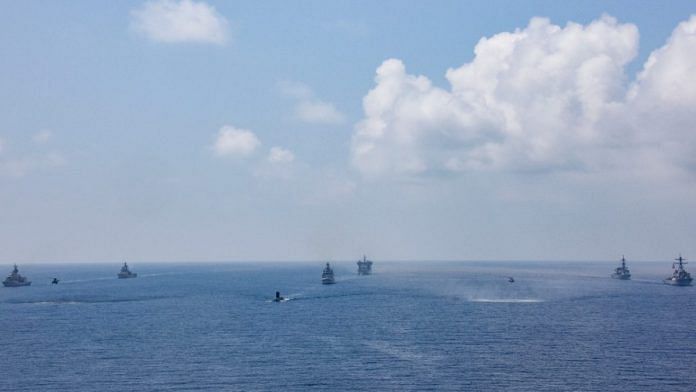New Delhi: With an emphasis on “open, inclusive Indo-Pacific and a rules-based international order”, the ‘Quad countries’ — India, US, Australia and Japan — will come together with two aircraft battle groups and a plethora of air power Tuesday to carry out the complex second phase of the Malabar exercise in the Northern Arabian Sea.
The US Navy’s potent Nimitz Carrier Strike Group including a nuclear submarine along with India’s Vikramaditya Carrier Battle Group will come together with the Japanese and Australian navy for the exercise until 20 November.
Having completed the Phase 1 of the Malabar 2020 earlier this month, the Phase 2 will involve coordinated operations of increasing complexity between the navies of the four countries.
The exercise, which began in 1992 as a bilateral India-US one, is seeing the participation of Australia for the first time in 13 years.
The Navy in a statement said the 24th edition of Malabar, which is being presently undertaken, “highlights enhanced convergence of views amongst the four vibrant democracies on maritime issues, and showcases their commitment to an open, inclusive Indo-Pacific and a rules-based international order”.
Phase 2 operations
Phase 2 will witness joint operations, centered around the Vikramaditya Carrier Battle Group of the Indian Navy and Nimitz Carrier Strike Group.
The two carriers, along with other ships, submarines and air wing of the participating navies, would be engaged in high-intensity naval operations over four days.
These exercises would include cross-deck flying operations and advanced air defence exercises by MIG 29K fighters of Vikramaditya and F-18 fighters and E2C Hawkeye from Nimitz.
Besides them, advanced surface and anti-submarine warfare exercises, seamanship evolutions and weapon firing will also be undertaken to further enhance interoperability and synergy between the four friendly navies, the Navy said.
In addition to Vikramaditya and its fighter and helicopter air-wings, indigenous destroyers Kolkata and Chennai, stealth frigate Talwar, Fleet Support Ship Deepak and integral helicopters will also participate in the exercise.
INS Khanderi, the second of the Indian Navy’s six Kalvari-class Scorpene submarines, and P8I maritime reconnaissance aircraft of the Indian Navy will also take part in the exercise.
US Navy’s Strike Carrier Nimitz will be accompanied by cruiser Princeton and destroyer Sterett in addition to P8A maritime reconnaissance aircraft.
The Royal Australian Navy will be represented by frigate Ballarat along with its integral helicopter. JMSDF will also participate in the exercise.
India and the US have agreed to expand their military relationship, especially in the Indo-Pacific, and the inclusion of Australia in the Malabar exercise is a step towards that front.
Former Navy chief Admiral Arun Prakash (retd) had earlier said while the inclusion of Australia may seem a symbolic move, it will have substantive geopolitical implications not only in the current China-India face-off, but also in the larger Indo-Pacific context where China is flexing its muscle.
Also read: Chinese research vessels in Sri Lankan waters come under Indian Navy lens




Alex Sir aise bol rahe hain jaise western liberals ne sanjeevni booti dundh li hai right wing ke liye ?
Quad countries Japan and Australia, together with New Zealand, South Korea, China and 10 ASEAN countries signed the biggest China-backed trade deal RCEP just yesterday in a challenge to the US, which is left aLone after Trump canceled TPP. The RCEP involves a third of the world population, 2.2 billion people, with $26.2 trillion GDP, THE BIGGEST DEAL EVER. Experts say that US should jump on this Chinese bandwagon by joining the RCEP to stay relevant in the Asia-Pacific region. All these countries want to do business with China. Even the president-elect Biden of the US is wearing the face masks made in China to protect himself and others from coronavirus. There wouldn’t be any of these naval ships and warplanes involved in the military exercises without the money earned from such trade deals.
India also got left out from the deal.
Not left out, India decided to opt out. China’s main objective is to destroy developing economies by pumping their cheap goods. Developed nations are some what immune. India does not have manufacturing at par with China and Service is not part of RECP so India has no edge in this deal.